Composition of tap water: requirements and methods for
What regulatory documents regulate the composition of tap water? Which parameters are normalized? What are the ways to improve tap water used in domestic conditions? Let's try to answer these questions.
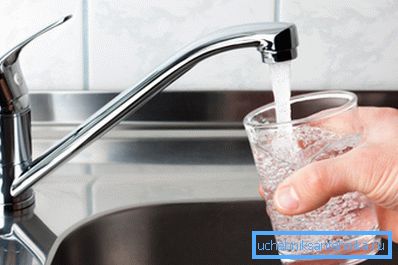
List of regulatory documents
What should be tap water according to GOST? Alas, here we are waiting for a not very pleasant surprise. Until recently, the hygienic requirements for tap water were set out in the Soviet standard GOST 2874-82. However, in 1999, the document was terminated.
Curiously: there was no full-fledged replacement for the standard in force. Currently, no GOST regulates the composition of drinking water supplied through centralized water supply networks.
However, it cannot be said that the quality of tap water is no longer standardized; The content of one standard is now divided into several different documents.
- GOST R 51232-98 contains descriptions of how to conduct analysis of tap water.
- GOST R 51211-98 offers methods for determining the content of surfactants in it.
- GOST R 51209-98 tells how traces of pesticides can be found in water using gas-liquid chromatography.
A complete list of documents describing methods for identifying certain potentially hazardous substances consists of about three dozen points. However, most of all, we are interested not in GOST, but in SanPiN (sanitary rules and regulations) under number 2.1.4.1074-01. He sets out exactly what the late Soviet GOST contained - the hygienic requirements for the water that flows from the tap.
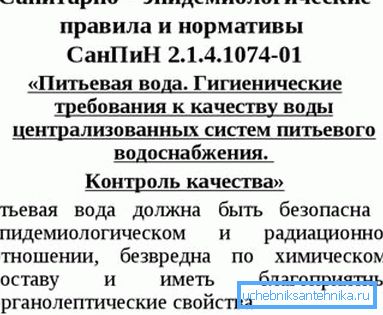
Regulatory requirements
Let's take a closer look at the key points of SanPiN.
General provisions
- The requirements of the document are required to comply with the development of new projects, standards, regulations and rules for the construction of new water supply networks and their operation.
- Operators are obliged to develop a procedure for monitoring the quality of drinking water, coordinating it with the local SES.
- In case of deviations from the norms, the operating water supply organization is obliged to notify consumers, representatives of the sanitary and epidemiological supervision, and proceed to eliminate the problem.

- In emergency situations, only those temporary deviations from the standards for chemical composition that affect the taste and smell of water are permissible.
- Temporary deviations from the norms are possible only if all of the following conditions are present at the same time:
- The population cannot be provided with drinking water in any other way, except for its transportation through the water supply network.
- All deviations from the normalized composition agreed with the local SES.
- Changes in chemical composition do not pose a threat to the health of consumers;
- The population is informed about the fact of deviation from the normalized composition, the duration of the force majeure situation and the absence of harm to health.
- If the time limits for the deviation from the normalized composition of water are exceeded or when it is potentially dangerous for the health of consumers, the water supply stops. The decision on termination of filing is taken by local authorities.
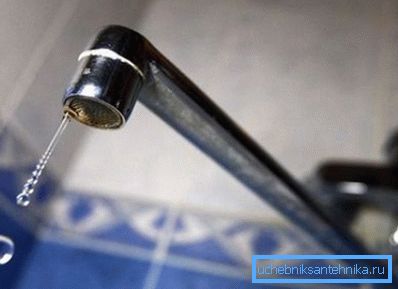
Hygienic requirements
Water should be harmless in composition and safe in radiation and epidemiological terms.
Biological safety is determined by the following standards:
| Indicator | Standard |
| Coliform Thermotolerant Bacteria | The absence of |
| Coliform bacteria (common) | The absence of |
| The total number of forming colonies of bacteria | Not more than 50 per 1 ml of sample |
| Coliphagi | The absence of |
| Clostridium spores | The absence of |
| Lamblia cysts | The absence of |
The document contains detailed instructions for taking samples.
- For research taken three samples of 100 milliliters.
- Samples are taken from the points of water pumping.
- If the total number of samples is not less than 100 per year, the excess in any of the listed indicators should be absent in at least 95% of cases.
Note: all water quality studies can only be carried out in licensed laboratories that are authorized by sanitary inspection authorities for relevant activities.
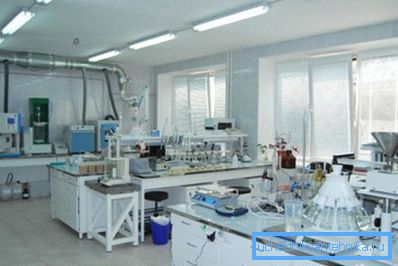
What is the chemical composition?
| Indicator | Standard, mg / l |
| Mineralization | 1000.0 |
| Rigidity | 7.00 |
| Oil products | 0.10 |
| Surfactant | 0.50 |
| Phenols | 0,250 |
| Aluminum | 0.50 |
| Barium | 0.10 |
| Beryllium | 0,00020 |
| Boron | 0.50 |
| Iron | 0.30 |
| Cadmium | 0,0010 |
| Manganese | 0.10 |
| Copper | 1.0 |
| Molybdenum | 0,250 |
| Arsenic | 0.050 |
| Nickel | 0.10 |
| Nitrates | 45.0 |
| Mercury | 0,00050 |
| Lead | 0.30 |
| Selenium | 0.10 |
| Strontium | 7.0 |
| Sulfates | 500.0 |
| Chlorine | 0.30 - 0.50 |
| Ozone | 0.30 |
| Formaldehydes | 0.050 |
| Polyphosphates | 3.50 |
| Polyacrylamide | 2.0 |
The pH should be in the Ph 6-9 range.
Curiously, chlorine, ozone, formaldehyde, polyphosphates and polyacrylamide saturate the water during its processing before it is supplied to the water supply system.
SanPiN contains a number of additional requirements.
- Microorganisms that are visible to the naked eye are not allowed in drinking water..
- The same goes for the presence of a surface film..
- When supplying water from underground sources, it may not undergo disinfection; however, in this case, samples are taken monthly or more frequently..

After crane
Is it possible to provide the best quality of drinking and used water for household purposes with your own hands? What if, for example, a child is allergic to tap water?
There are not many ways to improve water quality, and they are all widely known. We list the possible solutions.
Boiling helps get rid of free chlorine and is guaranteed to destroy all kinds of pathogens. Curiously, boiling also significantly reduces the hardness of tap water: the scum formed at the bottom of the kettle is a precipitated compound of calcium and magnesium.
Here, it is probably worth making a small lyrical digression. Hard water in the public consciousness is perceived as something negative: it forms the notorious scum on dishes and heat exchangers, settles on the inner walls of steel water pipes and on the inner surface of the toilet bowl, forming an untidy plaque.
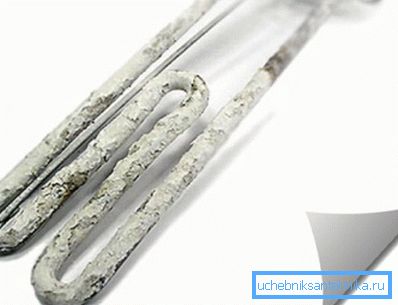
However, calcium compounds give strength to your bones and teeth. In the suburbs of Sevastopol, where the author lives, the water that is eroding limestone from underground sources is extremely rich in calcium salts; thanks to this, even deep old people can boast of healthy teeth and the absence of senile fragility of the skeleton.
How to remove chlorine from tap water without boiling, if water is supposed to be used as drinking water? By settling, it is enough to allow the water to settle in an open container for six to eight hours, and the content of free chlorine in it will decrease to almost zero.
How much to defend tap water for an aquarium, if its only problem is high chlorine content? In general, the same 6-8 hours. During this time, all volatile impurities leave it.

How much time to defend the tap water for the aquarium, if it contains visible amount of suspended matter or looks cloudy? About three days. During this time, suspensions are completely precipitated; then carefully enough, without disturbing the sediment, drain clean water.
How to soften tap water with a high content of lime used for washing or technical needs?
- For cosmetic procedures, shampooing, etc. just add a teaspoon of soda per liter of water.
- When washing, oxalic acid is often added to water at the rate of 2 grams per 10 liters. Curiously, the addition of acid causes precipitation of calcium salts.
By the way: by adding alkali or acid, it is easy to correct the low or high Ph of the tap water.
Finally, among the methods of water purification alone are different filters. Their price varies from 500 rubles for the simplest plastic jug with a carbon cartridge to 15-25 thousand for the treatment plants with a multi-stage filtration system that removes suspended matter, rust, oil products and other contaminants.
The only problem common to all household filtration systems for plumbing is the need to periodically replace cartridges, which requires not only costs, but also long-term support by the manufacturer of previously released products.
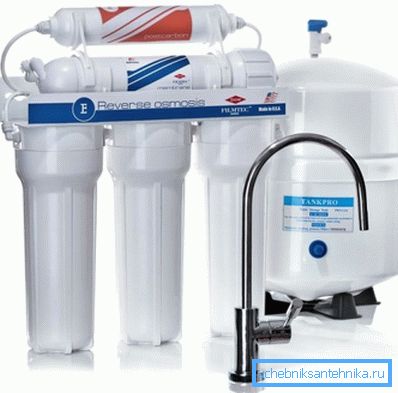
Conclusion
We hope that our acquaintance with the current standards of water quality and how to clean it will be useful to the reader. Additional information can be found in the video in this article. Successes!